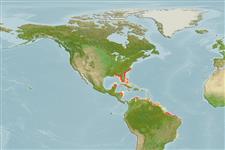Common names from other countries
Environment: milieu / climate zone / depth range / distribution range
Ekologi
Dasar (demersal); air tawar; payau; kisaran kedalaman 0 - 13 m (Ref. 116169), usually 2 - 5 m (Ref. 81178). Tropical; 38°N - 21°S, 89°W - 35°W
Western Atlantic: Trichechus manatus manatus: from the coasts and rivers of Mexico to as far south to Rio Doce, Brazil including the Orinoco and Amazon; Trichechus manatus latirostris: from the Florida Peninsula to Rhode Island. Tropical to temperate.
Length at first maturity / Size / Weight / umur
Maturity: Lm ? range ? - ? cm Max length : 390 cm TL jantan/; (Ref. 1394); Berat maksimum terpublikasi: 1.6 t (Ref. 1394)
Found in coastal marine, brackish and freshwater areas. Feeds on aquatic plants, (i.e. water hyacinths and marine seagrasses, algae, parts of mangrove trees, floating and shoreline vegetation); invertebrates (i.e. tunicates); and fish they remove from fishing nets (Ref. 1394). Found in coastal marine, brackish and freshwater areas (Ref. 1394), where primary habitat consists of rivers, coastal lagoons and bays and mangrove islands (Ref. 86755). Feeds on aquatic plants, (i.e. water hyacinths and marine seagrasses, algae, parts of mangrove trees, floating and shoreline vegetation); invertebrates (i.e. tunicates); and fish they remove from fishing nets (Ref. 1394).
rujukan utama
Acuan | Koordinator | mitra
Jefferson, T.A., S. Leatherwood and M.A. Webber. 1993. (Ref. 1394)
Status IUCN Red List (Ref. 130435)
status CITES (Ref. 108899)
penggunaan manusia
Perikanan: komersial
FAO - Perikanan: profail spesis | FishSource | Sea Around Us
Alat, peralatan
informasi lanjut
Umur / Saiz
Pertumbuhan
panjang-berat
panjang-panjang
Morfologi
Larva
Kelimpahan
Sumber internet
Estimates based on models
Preferred temperature
(Ref.
115969): 22.9 - 28, mean 26.5 (based on 562 cells).
keancaman
Very high vulnerability (90 of 100).
kategori harga
Unknown.
